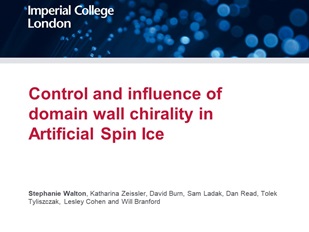
Control and influence of domain wall chirality in Artificial Spin Ice
S.K. Walton, K. Zeissler, M. Chadha, D.M. Burn, S. Ladak, D.E. Read, T, L.F. Cohen and W.R. Branford
APS March meeting Denver, Colorado Mar 2014
I will discuss arrays of single domain nanomagnets. The shape of each nanomagnets controls the magnetic anisotropy and the elements are closely spaced so dipolar interactions are important. Lattices are chosen such that the geometry prevents all dipole interactions from being satisfied. The building block of such frustrated lattices is the equilateral triangle because it cannot support simple antiparallel ordering. A two dimensional array of corner sharing triangles is known as the kagome lattice and a three-dimensional array of corner sharing tetrahedral is known as pyrochlore. Magnetic pyrochlore chemical compounds (spin ices) have recently attracted much attention with the observation of emergent magnetic monopoles, but they have limitations as model frustrated systems: tuning the lattice parameter by chemical doping tends to break the symmetry, specific defects cannot be engineered and the spins cannot be directly imaged. The use of frustrated artificial nanostructures overcomes these problems through the tremendous versatility in array fabrication and compatibility with a suite of magnetic imaging techniques. Here I will show direct magnetic imaging studies of monopole defects [1-2] and magnetic charge flow. [3-4] The magnetic charge is carried by transverse domain walls and the chirality of the domain wall is found to control the direction of propagation. In addition to magnetic imaging studies of the magnetisation state, I will also present magnetoresistance and Hall effect measurements. These techniques probe the array as a whole and can be very sensitive to the details of the spin structure. A change in symmetry in the Hall response of connected honeycomb nanostructures is observed at low temperatures indicating a collective response of the array of nanomagnets. [5]
[1] S. Ladak, D.E. Read, G.K. Perkins, L.F. Cohen, W.R. Branford. Nature Physics 6, 359, (2010).
[2] S. Ladak, D. Read, T. Tyliszczak, W. R. Branford, L.F. Cohen. New Journal of Physics 13, 023023, (2011).
[3] S. Ladak, S.K. Walton, K. Zeissler, T. Tyliszczak et al. New Journal of Physics 14, 045010, (2012).
[4] K. Zeissler, S.K. Walton, S. Ladak, D.E. Read et al. Sci. Rep. 3, 01252, (2013).
[5] W. R. Branford, S. Ladak, D.E. Read, K. Zeissler, L.F. Cohen. Science 335, 1597, (2012).